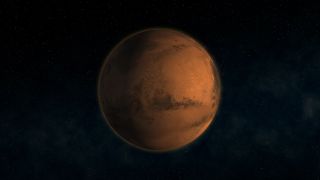Mars spacecraft may have to dig deeper than thought to find traces of life
Radiation might destroy intriguing compounds much faster than scientists realized.

Mars rovers may have to dig deeper to find signs of ancient life.
New research shows that certain protein-building amino acids that could be evidence of ancient life on Mars are more susceptible to radiation than scientists thought, meaning any amino acids left by life-forms might have only survived if they were buried deep beneath the planet's surface.
"Our results suggest that amino acids are destroyed by cosmic rays in the Martian surface rocks and regolith at much faster rates than previously thought," Alexander Pavlov, a space scientist at NASA's Goddard Space Flight Center in Greenbelt, Maryland, said in a statement. "Current Mars rover missions drill down to about two inches (around five centimeters). At those depths, it would take only 20 million years to destroy amino acids completely."
Related: Possible sign of Mars life? Curiosity rover finds 'tantalizing' Red Planet organics
While 20 million years might seem like an incredibly long time, this is a brief period in the development of planets and life. That's especially true when you consider that the signs of life that rovers such as Curiosity are searching for on Mars would have been present billions of years ago, when Mars was more like Earth.
The team discovered that the presence of liquid water, which was abundant on Mars billions of years ago, and perchlorate (charged ions of a chlorine atom surrounded by four oxygen atoms) could have sped up the destruction of amino acids. The findings were delivered by the first experiment to mix amino acids with simulated Martian soil.
The research suggests that we aren't digging deep enough beneath the Martian surface to discover signs of life. To address this problem, searches could shift their focus to locations where geological processes have brought buried rock to the surface.
Get the Space.com Newsletter
Breaking space news, the latest updates on rocket launches, skywatching events and more!
"Missions with shallow drill sampling have to seek recently exposed outcrops — e.g., recent microcraters with ages less than 10 million years or the material ejected from such craters," Pavlov said.
How Mars lost its magnetosphere
One of the major reasons Earth is more hospitable to life than Mars is that a strong magnetic field, the magnetosphere, surrounds our planet.
The magnetosphere protects Earth's atmosphere from the solar wind (charged particles from the sun) and fragments of other stars ( cosmic rays) by causing them to travel down magnetic-field lines and out behind Earth, similar to how a boat creates a bow shock as it travels through water.
These charged particles can degrade or destroy organic molecules when they penetrate yards of solid rock, ionizing and destroying everything in their path. Radiation from the sun can also strip away a planet's atmosphere , a key factor in its ability to hold on to liquid water.
Billions of years ago, Mars lost its magnetic field, its atmosphere and, eventually, a great deal of its life-sustaining liquid water. That means the search for life on Mars involves looking for the signs of ancient biological activity in Martian rocks via indicators such as amino acids.
To test how effective our current search is, the team of scientists mixed several types of amino acids in silica, hydrated silica, or silica and perchlorate to simulate conditions in Martian soil, and then sealed the samples in test tubes under vacuum conditions to simulate the thin Martian air.
While some of these samples were kept at temperatures similar to those on the surface of Mars, others were chilled to minus 67 degrees Fahrenheit (minus 55 degrees Celsius). All of the samples were exposed to highly energetic gamma-rays to simulate cosmic-ray exposure that rocks on the Martian surface would have experienced around 80 million years ago.
"Our work is the first comprehensive study where the destruction (radiolysis) of a broad range of amino acids was studied under a variety of Mars-relevant factors (temperature, water content, perchlorate abundance) and the rates of radiolysis were compared," Pavlov said. "It turns out that the addition of silicates, and particularly silicates with perchlorates, greatly increases the destruction rates of amino acids."
Researchers haven't found amino acids on Mars yet, but they have found these molecules in meteorites, including one from the Red Planet. But how these complex chemicals formed in the Martian meteorite RBT 04262, which was discovered in Antarctica in 2004, is still unclear.
As meteorites are usually ejected from at least 3.3 feet (1 meter) below the Martian surface, this new research implies that the amino acids in RBT 04262 may have been shielded from harsh solar radiation and cosmic rays.
The results also indicate that the complex organic molecules that the Mars rovers Curiosity and Perseverance have discovered, which intrigue scientists but are not indicators of life, may have been altered over time by radiation exposure.
The team's research was published June 26 in the journal Astrobiology.
Follow us on Twitter @Spacedotcom and on Facebook.
Join our Space Forums to keep talking space on the latest missions, night sky and more! And if you have a news tip, correction or comment, let us know at: community@space.com.

Robert Lea is a science journalist in the U.K. whose articles have been published in Physics World, New Scientist, Astronomy Magazine, All About Space, Newsweek and ZME Science. He also writes about science communication for Elsevier and the European Journal of Physics. Rob holds a bachelor of science degree in physics and astronomy from the U.K.’s Open University. Follow him on Twitter @sciencef1rst.
